An inefficient Notre Dame offense reliant on explosive plays through the air met up with an elite passing defense, and Cincinnati’s early turnovers and passing attack late held off the Irish for a massive win. While the game was full of self-inflicted errors at home for ND, Cincinnati wasn’t perfect either, squandering many scoring chances but creating enough explosive passing plays at key points to win both the efficiency and yards per play battles handily. After a disastrous quarterback play in the first half, Irish fans will have to hope Drew Pyne’s second-half performance is a sign he can breathe new life into the offense. But as with Jack Coan, he’ll have to deal with constant pressure, a non-threatening run game, and balance shots at big plays with turnover avoidance that can sink this wobbly Notre Dame team.
No garbage time in this close contest; only end of half possessions and kneel-downs were excluded from the data.
Confused? Check out this handy advanced stats glossary here or reach out in the comments.
Note: This week trying a new format weaving the same weekly stats you know and love into the storylines instead of separating things by the different categories. Feedback on this format versus the usual is very much appreciated.
Did Notre Dame really beat themselves?
One of the most useful applications of advanced stats is the ability to look back on a game and uncover how much the winner really outplayed the loser (or if they really did at all!). How much did elements that can be random but swing a game (like explosive plays, turnovers, or special teams) dictate the outcome? How do the teams compare in the core phases of the game (efficient offenses, number of scoring chances created)? Was there any element of the game script with a team building an early lead, significant injuries, or garbage time that changed the path to the final score?
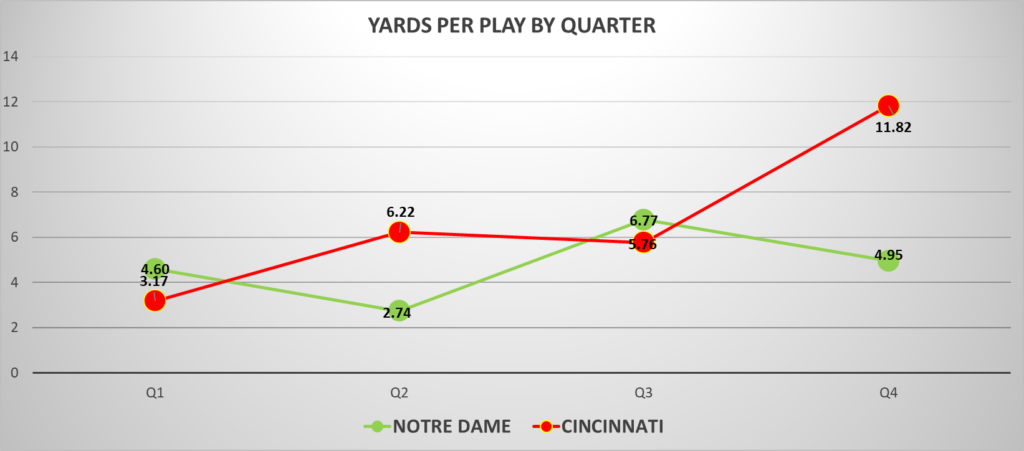
Immediately after the loss to Cincinnati, the idea popped up that this was a winnable game the Irish lost with self-inflicted errors. And there’s certainly truth to that – from the costly turnovers to start the game to QB mismanagement and uncharacteristic penalties. But it’s also a convenient narrative that ignores Luke Fickell’s team winning in each phase of the game no matter how you parse the numbers. Even when Drew Pyne injected life into the Irish offense, Cincinnati still was more efficient and explosive. Even if you remove some of the scoring chances gifted by Notre Dame turnovers, the Bearcats still created more.
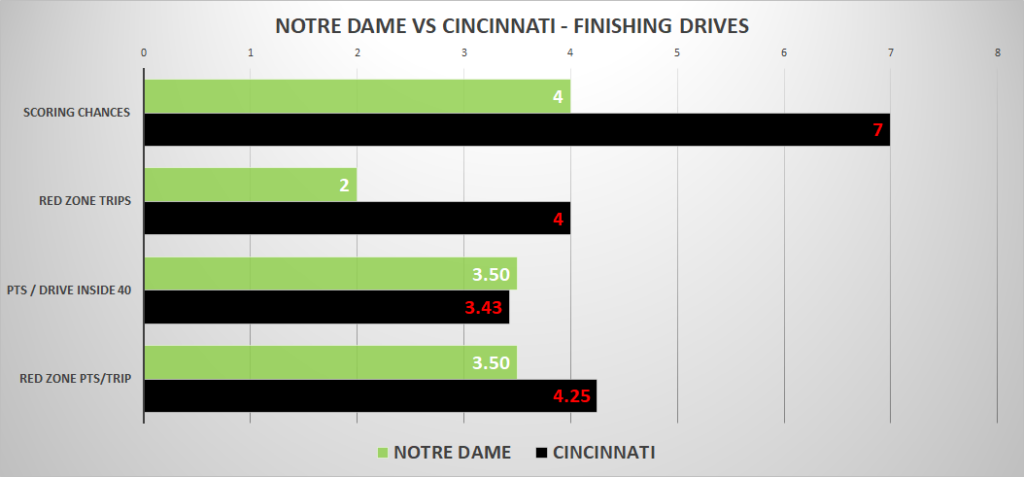
And if we’re going to start revising what could and should have happened for the Irish in an imaginary clean first half, we also need to acknowledge Cincinnati’s easy improvements. The Bearcats created seven scoring opportunities in 12 possessions, and four of those chances resulted in a grand total of three points. If not for the offense stalling out, a costly strip sack where Desmond Ridder held on to the ball too long, and some #collegekickers misses, Cincinnati could have avoided the temporary 4th quarter drama.
The visitors were very close to hanging 35 points on a Notre Dame team that had no prayer of scoring enough to keep up. Cincinnati finished with a margin of +2 yards per play and +8.3% efficiency. The Irish may have managed to carve a brief path to an upset capitalizing on a crucial turnover and missed kicks or played a tighter game capitalizing on the early defensive success. Still, they weren’t the better team in any phase.
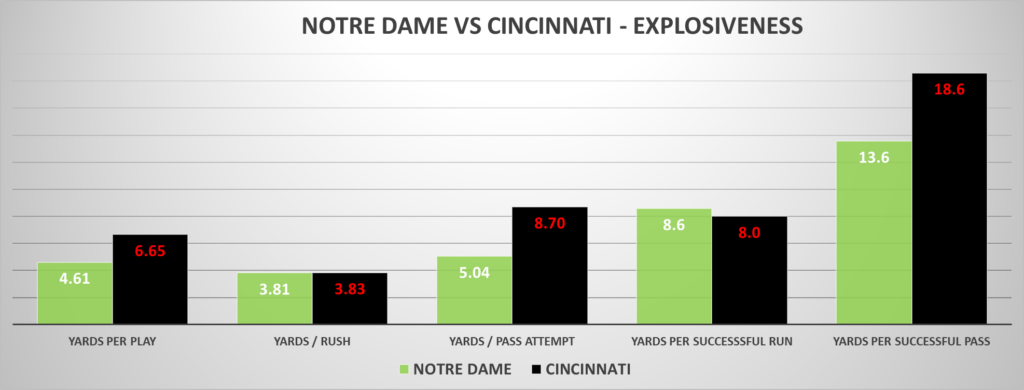
Maybe the most surprising big-picture development of the game was Ridder’s ability to find passing windows in the soft underbelly of Notre Dame’s passing defense. While the most talented opposing QB the Irish have faced, Ridder struggled historically against solid defenses. But Mike Denbrock and the Bearcats could find some space with Alec Pierce beating Clarence Lewis for some long gains and some well-designed plays to get tight ends down the seam.
It’s too early to pull fire alarms on the passing coverage – Cincinnati was just 2 of 11 on 3rd downs, and the Irish defense was impressive early. But Ridder’s performance was more confirmation that soft spots in the secondary still exist despite strong performances against Big Ten passing attacks. Marcus Freeman will have to problem-solve as the next three games will bring three excellent receivers in Tre Turner, Drake London, and Josh Downs.
Building offense on a cracked foundation
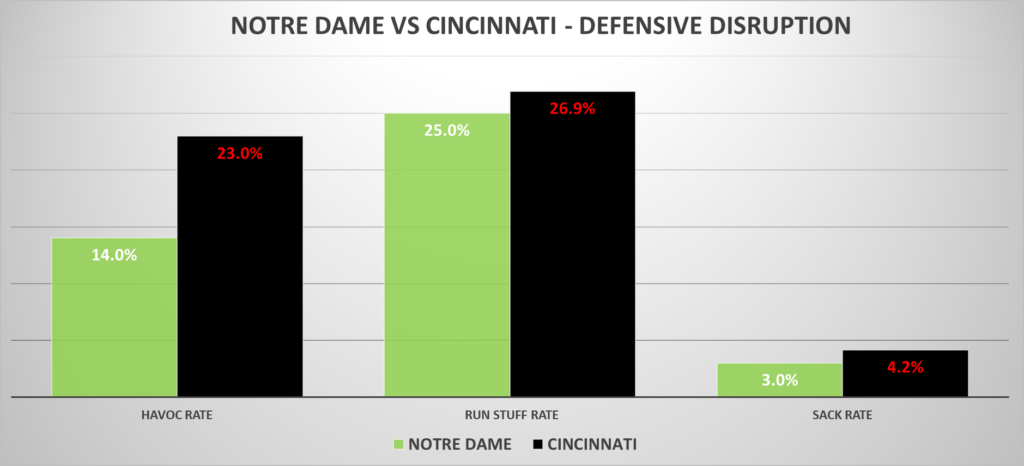
After finishing with less than four yards per play against Wisconsin, the Notre Dame offense again struggled against an elite defense. Before delving into spins on the random wheel of quarterbacks, the issues start on the ground where the Irish aren’t efficient or explosive regardless of opponent. Kyren Williams and Chris Tyree are so talented it feels like Tommy Rees feels obligated in each game to give them early carries and probe if this is the matchup or adjustments that can finally break through. But predictably, against the tough Cincinnati defense, Notre Dame runs were equally likely to be stuffed as successful (26.9%).

What’s striking about the decline for Williams and Tyree’s numbers is that it’s across nearly every metric. It’s not as if on the few times they find success they’re routinely breaking long runs – Williams managed to escape for a long touchdown each against Toledo and Purdue, but these have been the exception to the rule. Tyree has a long carry of 12 yards. Kyren broke the two 40+ yarders in the first two home games, but the 10-20 yard runs that fueled much of the 2020 offense have entirely evaporated. As an aside, this is a good case study in how little running backs can control in even some of these more in-depth rushing stats.
Notre Dame had a relatively even split on early downs of 25 rushes and 28 passes despite these struggles. Those runs averaged 3.6 yards per play and led to a 28% success rate; passes weren’t light-years better but improved those numbers to 4.5 yards per play and a 36% success rate (5.6 / 36% with Pyne). The offense certainly can’t abandon the run game entirely, but close to a 50/50 split, especially against better defenses, appears to be way more of a commitment to a struggling ground game than optimal. With the two most formidable defenses on the schedule behind him, it’s a massive question if Rees remains stubborn probing on the ground on early downs. Will he continue to try to get his RB tandem touches and take pressure off an unsteady QB position? Or will eventually embrace the spread-it-out / air-it-out approach?
Back on the QB carousel to salvage the offense

For a while longer, it feels like Ian Book, former 3* QB installed midseason and who had to fend off a blue-chip prospect behind him, will be the most normal quarterback experience of the Brian Kelly era. While nothing is official after a second consecutive game coming in off the bench and outproducing Coan, this seems like Drew Pyne’s job.

It’s worth noting that the Pyne experience, like with Coan and Buchner, is going to be a rollercoaster. In his small sample of throws, Pyne has thrown a lot of contested passes. Many of these have been sorely needed to give receivers a chance and tap into the offensive upside, like the touchdown pass to Lenzy. But seven of his 26 pass attempts have been broken up by defenders, a high rate that will lead to interceptions sooner rather than later. Any quarterback will take sacks with this amount of pressure; Pyne’s just may feel more aesthetically pleasing than Coan’s.
Pyne will also have to walk a tricky tightrope measuring risk versus reward early in his career. The passing game necessarily has to be the engine of the Irish offense and score the 20-30 points needed each game to win. Despite all the skill position talent, it’s simply not realistic at this point to expect a wealth of scoring opportunities each game, so the offense has to maximize their chances in opponent field position and creating big plays when opportunities arise. But as the Cincinnati game demonstrated, the offensive inconsistency paired with a good (but not dominant) defense means that the offense absolutely can’t turn the ball over multiple times either. Rees and Pyne will have to make good decisions so that the drives that aren’t working out do no harm, yet they still can generate enough offense to win.
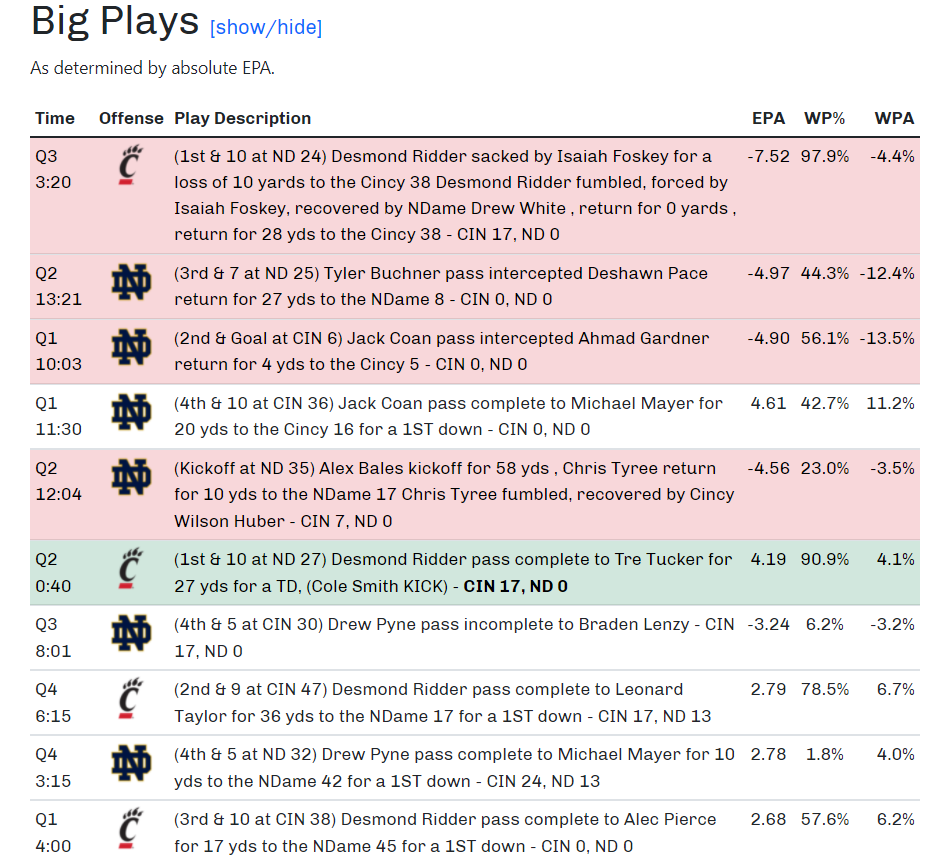
Those decisions will be especially critical on third downs. Against the Bearcats, the Irish averaged 8.9 yards to go in these spots, which makes converting 6 of 17 opportunities far more impressive. If there’s any upside to this situation, the learning curve for Pyne and some of the young Irish receivers may be rapidly accelerated, especially if Joe Wilkins misses significant time and Michael Mayer is limited. Throw in the Joe Alt timeline continuing at an insane rate – from the way the staff discusses him, he seemed like a shoo-in for a tackle spot next season even if redshirting this year – and the “play the kids, this is a rebuilding year” advocates may be getting what they hoped for out of necessity.
Where do the Irish go now?
A quick note on the recurring topic of Irish home crowds and worries about visiting fans – I’m not sure why people feel so much angst on this topic, but it always feels like a reactive doubling-down when there’s a loss that this is a huge problem. Notre Dame is always going to be susceptible to this sort of thing with a spread-out fanbase and local season-ticket holder base that’s smaller or arguably more casual than a lot of other places.
For a Cincinnati fan, this is a once-in-a-lifetime opportunity. To have the team at this level, ranked top-ten nationally playing in South Bend, it’s hard to put a price tag on that kind of experience and it’s an easy trip. Meanwhile, for Notre Dame fans planning on trips this offseason, this was either the third or fourth biggest draw depending on how you feel about the Shamrock Series game and UNC? (With perfect 20/20 hindsight, this probably should have been a night game and UNC an afternoon kick). In the modern era, there will always be a good percentage of tickets available on the secondary market, and it’s just not realistic that Notre Dame fans are going to outspend away fans unless the matchup becomes a can’t-miss showdown.
The Massey composite top 40 today. Not sure how many tiers will develop between 3-40 but it doesn’t seem like much separation. Going to be a season to survive parity and randomness to make fun bowls / keep recruiting momentum going / double-digit win streak if at all possible pic.twitter.com/tZw6NGu02S
— Michael Bryan (@michaelbryanMB) October 3, 2021
Zooming out, in a year with exceptional parity, the Irish are in a massive tier of flawed but talented teams. Top 20? Top 40? How much reliable separation is there between Cincinnati, Notre Dame, Iowa State, or UCLA? More than usual it seems like on any given weekend any of these teams can take each other out.
Wherever Notre Dame stands, the inability to separate from opponents has been a consistent theme. The Irish played FSU evenly, had their most separation against Toledo but nearly lost thanks to turnovers, were less efficient than Purdue, and had fewer yards per play than Wisconsin. The offensive struggles will translate into low-scoring games where it’s easy for a turnover, explosive play, or penalties to make things tight. Play enough one-possession games and eventually, you’ll drop a few. It’s an uncomfortable development for a team this talented that suddenly there’s the chance the Irish offense could be the weakest unit on the field in many games remaining on the schedule.
The heart attack games aren’t ending. But the defense under Freeman can continue to gel, and Pyne has a shot to raise the offensive floor. Brian Kelly’s goal will be to grind out as many of those close games as possible, keep hope alive for a major bowl game, and ensure that future recruiting momentum doesn’t stall. Extending the double-digit win streak in a rebuilding year would further solidify Notre Dame’s place toward the top of the tier just after the perennial playoff teams; a slide down to 8-4 might signify the Irish aren’t as separated from the pack as their 2018 and 2020 playoff appearances might imply.

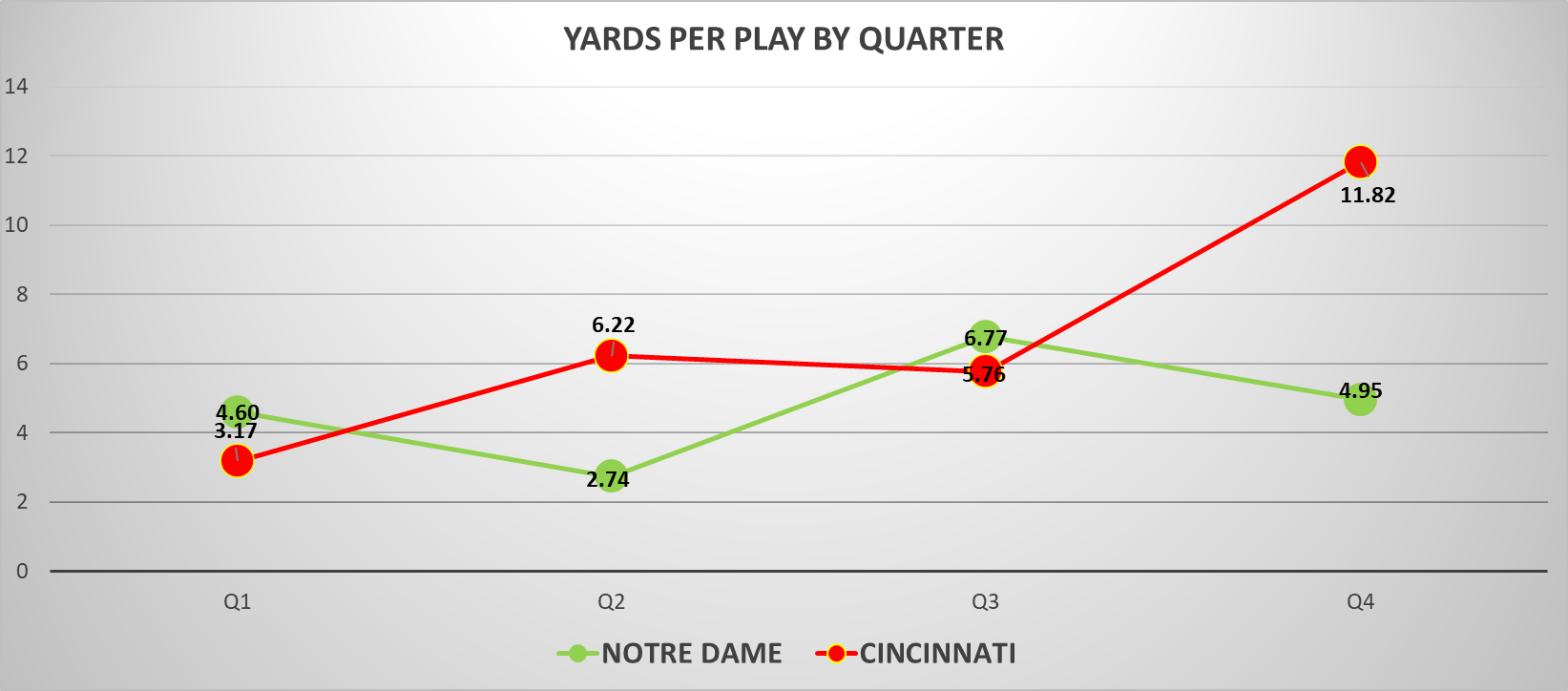



Great analysis and those numbers showing that Cincy produced better than ND across the board showed that ND was outplayed and the score could have been worse.
I have a couple of questions. First, while Pyne outperformed Coan, do we have to be concerned with the fact that defenses will start adjusting for him now that they have some film? Also, do advanced stats care much about sacks? Or do advanced stats care much more about turnovers?
Really good question – without going too far down a nerd rabbit hole, it depends.
In terms of what determines a game, definitely turnovers. I’m not the biggest EPA fan but does apply really well for turnovers. If you fumble at on opponent 50, you were expected on that drive to score a little less than 3 points and now you have zero and your opponent has that expectation. A six-point swing like that is massive, and it can apply even more if you have a big runback, are on the opponent doorstep, backed up, etc.
In the long run, the turnovers are fairly random so emphasized less when it comes to projections and predicting outcomes. The sacks are impactful for sure but ultimately get baked into other stats. It probably has the biggest direct impact on efficiency, because they either end a drive altogether (on 3rd down) or tend to tank the following plays too by creating long distances to gain.
It seemed to me most people were thinking Freeman would come here, excel, and be gone serving 2 years and maaayyybbee 3 years as DC.
But with not having an elite defense and the team doing worse than we thought I think we can be a relatively certain that (as long as he does well) he’ll be around more like 3 or 4 years if not longer (I get the sense he’s going to picky with what job he takes).
But how long will Rees be here?
It’d be pretty hard to move from him after this year. But if next year’s offense doesn’t get much better (esp. at QB) his seat is going to get warm.
And from his end, what is he trying to do? Does he want to be a head coach at a mid-major/low-end major program? Something else?
Rees never seemed to have the hype/juice for getting a big job even after doing great work last year.
Tommy’s 29 and had been a coordinator for one year last offseason! He was still playing QB when Freeman was a P5 position coach.
His long-term stock is probably pretty good, although it’s hard to have good objective feedback since he’s been so close to ND. But reportedly Northwestern and Oregon had interest in him as OC after Chip left. I’m guessing eventually he wants to be an HC but understands getting a few years of experience as a coordinator is a prerequisite given his youth.
“But reportedly Northwestern and Oregon had interest in him as OC after Chip left.”
This one hundred percent seemed like something ND played up at the time to justify hiring Rees when he would not have been seriously in the run any other jobs of similar caliber (he was obviously not seriously in the run for Oregon given that they hired Joe Moorhead). It was pretty transparent that was the case when all the beat writers all started talking about it at the same time.
If he were let go tomorrow, he would very likely not be a D1 offensive coordinator next year. He is a ways off from being a head coach.
The Northwestern aspect of wanting to interview him seems extremely plausible. I don’t know who officially reported what, because if I recall the situation was Fitzgerald wanted to interview him and essentially Rees declined because the ND opening. There’s obviously the relationship there from Rees being a GA. Oregon is more suspicious, and again without him actually traveling out there and interviewing (to my knowledge) hard to know what’s real.
That last sentence seems like a LOT of projection. Agree on being a ways from HC (simply because of experience, regardless of performance). But laughable to think Rees couldn’t get a FBS OC job. Brian Van Gorder, who was older and had a way worse tenure, managed to get two DC jobs after ND!
Beyond projection, more bordering on the absurd. Tommy Rees couldn’t get an FBS OC job after a mostly successful stint at Notre Dame? (insert Jennifer Lawrence OK.gif)
And although Rees has been fairly meh so far, he’s been wayyyy better than BVG.
Just perception, IMO. Not calling Rees the next Joe Brady or anything, but I bet he’s seen in the coaching world a lot closer to that as a “young rising star who has already made Ian Book an NFL pick and done well with a great line” a lot more before anyone would think to evoke the name of an old, crappy retread like BVG..
Also, there’s the fact that Mike Sanford falls into P5 FBS OC jobs. Rees would be hired as soon as he wanted, possibly/probably for a meaningful position in a heartbeat if available.
it’s probably all about what comes available and how picky he will be, right? I don’t think his stock has probably changed much this year as a HC candidate. He’ll be on a lot of short lists for decent G5 and lower P5 jobs. close this year strong, perform well next year, and the quality of P5 opportunity only gets better. if and when Fickell moves on he’s probably top of that list, which could be any offseason (although he seems pick as well).
For those who haven’t seen it, Prister has a new article at Irish Illustrated examining the o-line in more depth. Nothing ground breaking, but a good read about the different ways things are going wrong (and without explicitly saying it, the article gives a pretty good impression that the line needs better coaching)
Prister was banging that drum very loudly when Quinn was announced as Hiestand’s replacement, and has conveniently avoided revisiting that opinion through the three intervening seasons of pretty good to very good OL play. His op-ed when the hire happened could’ve been ghost-written by El Kabong. For that entire offseason, he literally couldn’t mention Quinn without saying he wasn’t Hiestand.
I also think Prister’s source for much of his “nobody wanted Quinn” stuff back then was Chip Long, who *hated* Quinn. In fairness though, Chip hated everyone and wasn’t shy about letting them know it, which is why he isn’t here anymore. Probably also why he didn’t get a sniff for an on-field role at former stops Memphis or Arkansas, who were both in the market for OCs that offseason, despite his rumored interest in both jobs. Recall that he ended up as an analyst on Jeremy Pruitt’s final Tennessee staff and wasn’t retained by Josh Heupel when he took over.
What I’m saying is, consider the source. Prister has had an axe to grind with Quinn from the beginning. I think Prister loved Chip because he was (a) run-first and (b) and an old-time hardass (which of course is why everyone else couldn’t stand him), and probably thinks Chip was done wrong by Kelly and the other softies around the program.
The OL has serious issues but they’re almost entirely about talent deficiency, not coaching. Joe Moore himself couldn’t turn Cain Madden into Aaron Banks, or Josh Lugg into Ronnie Stanley. The experienced guys we have are short on talent. The talented guys are short on experience. Why we’re in this situation is 100% worth examining, but it has little to do with Quinn’s coaching acumen.
Well put. It also kinda reminds me of the War of J*rdan J*hnson where Prister praised him and ranked him in the top 50 as a potential contributor (and the 5th or 6th best WR on the team in 2020), then when JJ bombed out, Prister said they knew all along the player wasn’t that good and never fit in and didn’t see the field because he stunk, why is anyone even surprised? (Even though it was his own hype that partially helped fuel the fan interest)
Can’t really grind that axe on Quinn in 2019 and 2020 when the line play was good, but now he’s got the chance to really give it to him and pile on when it’s bad.
All that to say, I agree with the end that the situation is very troubling and worth action somewhere to correct for the future, but the media slants and timing is always very curious, especially from that outlet.
That’s really helpful context.
Which is why I’m a bit skeptical of the evidence to get rid of him after one bad year. But perhaps looking into recruiting would give one the kind of evidence to come to that conclusion.
2017 (HH) – Hainsey (#84), Lugg (#120), Banks (#166), Gibbons (#374)
2018 (mostly HH, Quinn hired here – I think I remember someone mentioned he was responsible for bringing in Patterson) – Patterson (#365), Dirksen (#515), Jones (#516), Mabry (#716)
2019 (Quinn) Correll (#95), Carroll (#118), Kirstofic (#183), Olmstead (#185)
2020 (Quinn) Baker (#100), Carmody (#146)
2021 (Quinn) Fisher (#55), Spindler (#60), Johnson (#322), Alt (#406), Coogan (#611)
The real disasters were in 2018 + 2019 (though having a legit starter from the 2017 class would have helped). It seems the blame is roughly 50/50 with HH and Quinn with those classes. I think the 2020+2021 classes are too young to come to any conclusions about their quality. Baker and Carmody could easily develop into solid starters still it would seem to me.
Quinn probably needs to bring in one more top 200 player in 2022 for it to be a solid class.
2022 (so far) – Tanona (#166), Chan (#175), Craig (#496)
I don’t agree with much of the II take here. I’ve never thought Prister , from what I’ve read and heard, thought that getting rid of Long was a mistake. Far from it. He’s conveyed that Long’s problems were self inflicted by his personality and he needed to go.
Prister didn’t like the Quinn hire, as many didn”t. With the disaster we have on the Oline now, anyone NOT calling for a re-evaluation of the Oline coach, would, I think, be the opinion to question. I find Prister to be as reasonable as anyone, when it comes to evaluating coaches. He’s not always correct but, he’s usually sensible and rational. “piling on”, in this case, I think not.
Interesting that Clemson is still the top ACC team in the Massey ratings.
The last sentence is interesting. If where the ceiling of where the program currently is at is something like “nationally as a program we should be considered as good as Georgia or Oklahoma”, what is the floor? “Notwithstanding we made the playoffs twice in the last five years, in terms of our level of play we’re really more like [who]” Penn State? A&M? Wisconsin?
This was a really good question that inspired some research – see below:
https://twitter.com/michaelbryanMB/status/1445751658676305920?s=20
Very interesting – thanks for doing the digging! I guess my instincts were pretty good with Penn State and Wisconsin but not so good with A&M.
Great work? I know the Spartans had a playoff experience but aren’t on the list? They must really be an outlier.
Sorry, that was supposed to be “Great work!”. Haha.
Let’s not group Oklahoma and Georgia together. Georgia has a much higher ceiling.
ND and OU have basically had the same ceiling for the past 10 years. OU has definitely had a higher floor and been a better team on average. But they’ve always been pretenders who dominate a paper soft schedule, lose at least 2 games every year, and absolutely no show against ELITE teams, just like us.
They pushed Georgia in 2017, who pushed Alabama, but other than that, yeah, they’ve been just as paper playoff tiger as we have. Pretty funny that somehow it’s never held against them.
Honestly, I just think it isn’t held against them because they are OU. No one really cares. Their fanbase isn’t as obnoxious as ours, their only rivals are mediocre, and they are in Oklahoma.
Also, they score tons of points against awful teams, like Michigan.
I think the – score a lot of points and having some elite QBs – is the main reason it’s not held against them. Somehow that makes a team look better than it actually is (or can anyway).
All true. I think it kind of does get held against them come playoff time, the perception is they’re just going to get blown out by an SEC team. I think they were like 2 TD underdogs to LSU, so it’s not like they’re really seen as worthy by many, just a high-tempo offensive with a lot of talent in skill positions but not enough steak to compete with the real titans.
That’s fair. I guess to me the “we’re at the top of the second tier” thing is just clearly wrong, though, because our program is not Georgia, which is clearly at the top of the second tier and we are not on their level. One can quibble with whether it would be better to be ND or Oklahoma or LSU (the LSU argument being “at least with our talent level if things break right we are capable of winning and have won playoff games”, which barring playoff expansion is a definite no in the foreseeable future for ND and a very very likely no for Oklahoma; the anti-LSU argument being, well, most seasons).
Though the tweet from MB above seems to indicate that Oklahoma is pretty clearly ahead of us in tier 2.
After that tweet, I see 5 distinct tiers
1: Bama
2: Clemson, tOSU, UGA – talented enough to compete for NCs every year. Ceiling is NC.
3: OU – best of the rest, not talented enough to really compete for NCs. Consistently competing for playoff spot
4: ND, Wisc, PSU, Auburn – really good football teams, not talented enough and not as consistent as OU, but still usually competing for playoff a spot.
5:Everyone else – good teams, ups and downs, could make a playoff, but rarely.
If you’re putting a lot of stock in F+, sure. IMO there’s a really big gap between a Notre Dame team that’s won 84% of it’s game and received 2 playoff berths compared to teams that have won 62-72% of their games and never really even sniffed the playoffs.
I think there’s something to be encouraged about there in terms of winning close games / overachieving a bit. But if we play Auburn on Penn State’s schedules the last four years there’s no doubt our win % is way lower. And probably no playoff berths.
Now, you could flip that – I don’t think Auburn or PSU would have been able to replicate the 2018 / 2020 undefeated reg seasons. But still, I think relying on win % there is misleading.
I think it’s reasonable to believe that Auburn, PSU, or LSU could have and maybe would have made the playoff at least twice since it started if they were playing our schedules. I do not think that about Wisconsin, which is why I would say they’re at the bottom of whatever tier we are talking about.
Fair point, and perhaps there shouldn’t have been a total emphasis on winning%, even if there’s a telling difference. Further, in this time frame both Auburn + Penn State have lost to some teams in the past few years that Notre Dame consistently has beaten (Auburn – 2018 Tennessee, Miss St., 2020 South Carolina, Northwestern; Penn State – unranked Michigan St a few times, Marlyand, Nebraska, Indiana last year). Whereas, Notre Dame in the past four years hasn’t lost to anyone but top 5-10ish ranked teams, which is a distinction between the programs, though how much weight one wants to assign it is up to them.
There certainly is a similarity where these teams, along with ND are sort of what a wrestling fan might call “jobber to the stars”…Where you have a really good talent, but he’s always going to lose to the champion. That’s certainly the case where there’s a Bama, Ohio State type in the mix, though Notre Dame also has an outlier for actually beating the #1 team in the country, as well..
I guess what has stood out to me, and maybe it’s too results based, but I would put ND closer to Oklahoma than to Auburn over the past four years.
LSU is in your tier 4 for sure, and probably should be considered ahead of Wisc/PSU/Aub. I think there really should be some weight on the “plausibly can win playoff games in an up year”, which isn’t really a thing you can say about any of those other tier 4 teams.
I’d be pretty fine switching Wisc and LSU. But LSU other than that one year, really hasn’t been near that tier 4. They could probably be their own tier (which could either belong above OU or below ND): Talented enough to win a NC, but poorly coached, really low floor, and wildly inconsistent.